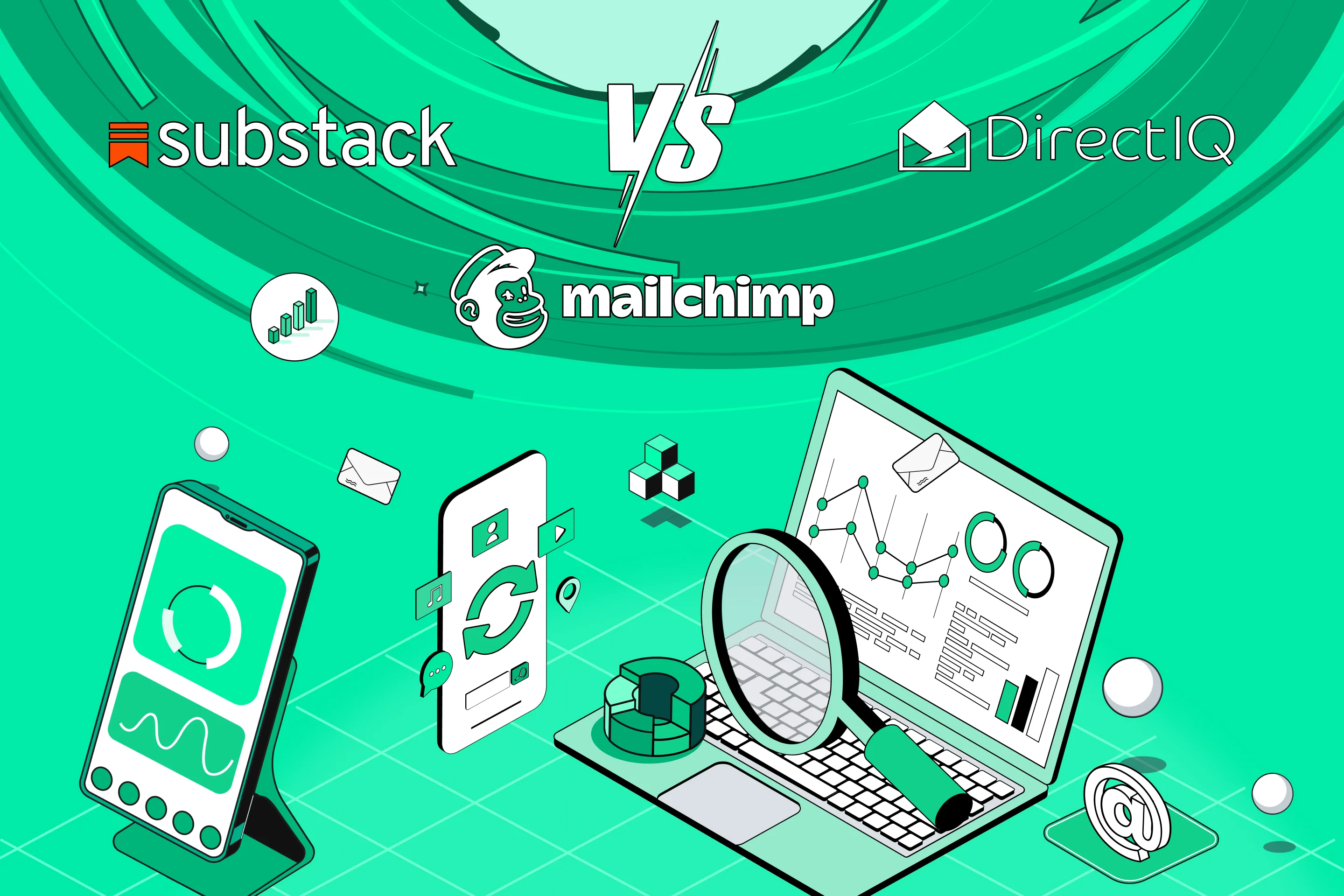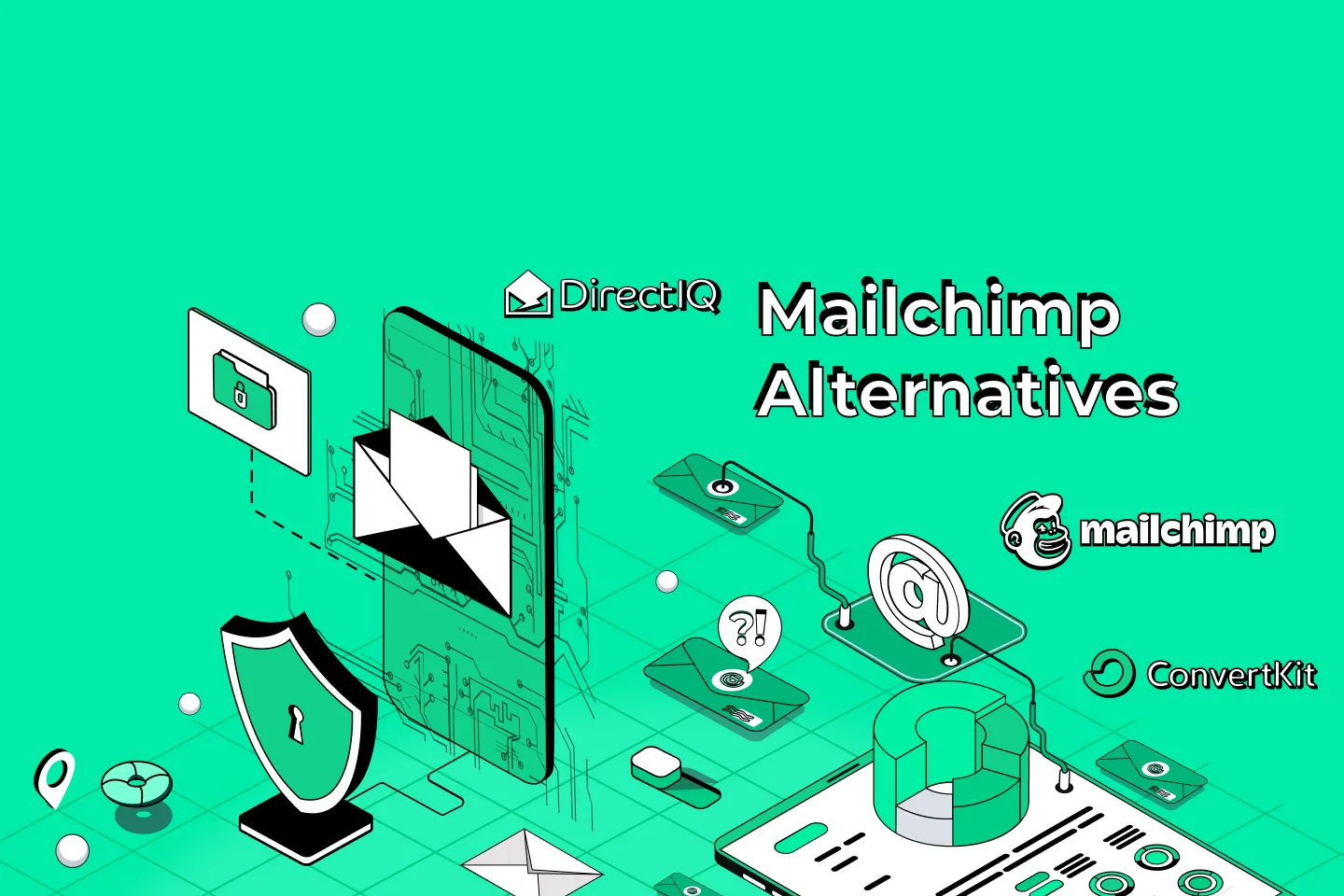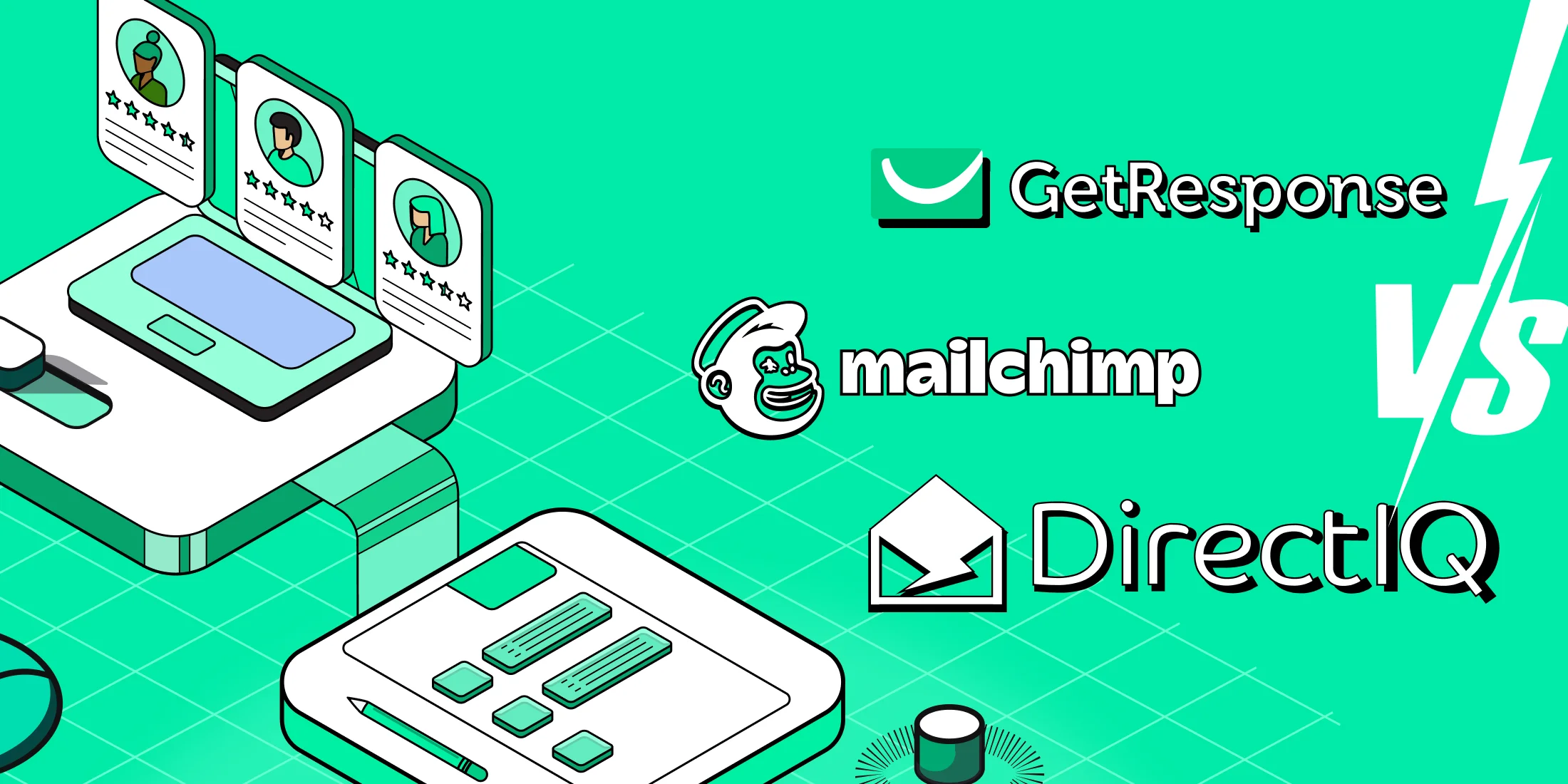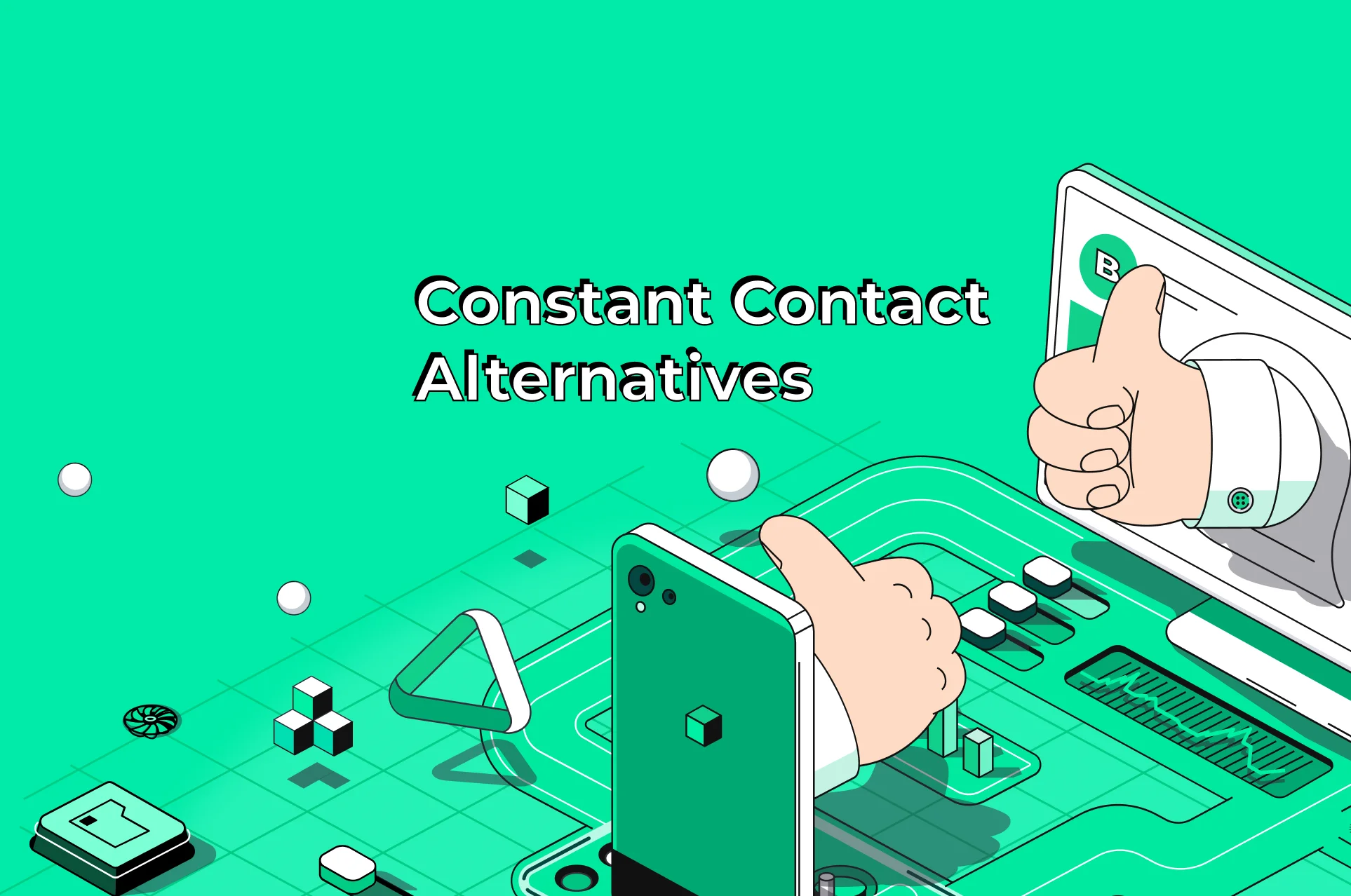Substack Vs Mailchimp Vs DirectIQ (2024 Comparison)
Substack vs Mailchimp vs DirectIQ – which is best? With no shortage of email marketing tools available for businesses to choose from, it is important to separate the good from the bad. These three content and email marketing platforms stand out from the crowd and represent the best of what’s available. Our whistlestop guide will determine which tool is superior.
Table of contents

What are Substack’s best features?
For its clear focus on newsletter publication, Substack has quickly acquired traction among writers, corporations, and content creators. Substack is appealing for those who want to monetize their writing or frequently engage with their audience through long-form material because it focuses on content development and delivery rather than a wide range of other services.
Substack’s ease of use is one of its greatest strengths. Its intuitive drag-and-drop editor makes it easy to create visually stunning newsletters even for individuals with little experience with digital tools.
Substack provides a wealth of themes and design features that enable designers to make their newsletters stand out, without sacrificing design or usefulness.
Substack’s built-in analytics are one of its best features. Substack delivers insights into reader engagement, helping producers learn which material is most well-received by their target audience beyond simple metrics like open and click rates.
For making improvements to content and methods, this is priceless information.
The ability to earn money is also what makes Substack unique.
Creators can monetize their newsletters through paid subscriptions or premium content offers with the help of in-built capabilities that allow them to charge subscribers.
What is Substack’s pricing structure?
No matter how many subscribers you have, publishing is free on Substack. When you add paid subscriptions into the mix, Substack takes a 10% cut. There is a credit card fee charged by Stripe, their payment processor.
Substack’s 10% cost may seem high at first, but it’s justified after you factor in the infrastructure, hosting, analytics, and support the platform offers in exchange.
Substack’s success is proportional to the success of its authors because of the price system; the more a writer or content creator earns, the more money Substack makes.
In conclusion, Substack’s open pricing and no-cost publishing strategy make it a great option for both new and seasoned content providers.
The health of the platform’s community is directly proportional to the health of the platform itself, so users can be assured that the platform’s resources and features will always be improved with the creator in mind.
What are Mailchimp’s best features?
In the world of email advertising, MailChimp needs no introduction. It has matured into a robust system that serves the needs of both inexperienced and seasoned marketers.
While its primary purpose is to simplify the process of producing and distributing email newsletters, it also provides a robust collection of features to help organizations manage effective email campaigns.
The user-friendliness of Mailchimp’s UI is a major selling point. Users are able to rapidly become acquainted with the platform because to its well-designed interface and menus.
An intuitive drag-and-drop editor greatly streamlines the composition of professional emails. Users may create engaging, professional-looking emails without any knowledge of design or code.
Mailchimp’s versatility means it can be used for more than just sending emails. Its wide variety of connections makes it easy for organizations to link their email campaigns with other services they use, such as customer relationship management systems, online storefronts, and social media networks.
Because of the seamless data transfer between systems made possible by this ecosystem, marketers may launch more specific and relevant ads.
Email marketing relies heavily on successful delivery.
Even the most carefully crafted email is useless if the recipient never sees it. MailChimp’s strong deliverability rates can be attributed to the company’s reliable infrastructure and strict adherence to industry standards for sending email. Mailchimp users may rest assured that their customers will receive their messages.

Mailchimp Review
As of the writing date, Mailchimp has 4.5 out of 5 stars and 15,470 reviews on Capterra.
“One of my favorite things in Mailchimp is undoubtedly customer support. Very fast and really helpful. Even if the application is very complex, they can definitely find a fast and effective solution for you. Also, they are very polite. I wish the interface improvements of the application were made as soon as possible, so we did not need so much customer support.”
Click here to read more reviews.
What is Mailchimp’s pricing structure?
Mailchimp’s pricing structure is made to accommodate a wide variety of customers, from solopreneurs just getting started with email marketing to multinational conglomerates with millions of email addresses.
Mailchimp ensures that businesses can choose a package that corresponds with their needs and budget by dividing its products into a free plan and several paid tiers.
Effective communication begins with knowing who you’re talking to, and the marketing CRM, even in its free version, helps firms do just that.
The more complex capabilities of Mailchimp’s subscription plans may become necessary, though, as a company expands and its needs become more nuanced. Here are some of the features that are unlocked with paid plans:
- Emails can be sent to subscribers based on their actions or behaviors on a company’s website, a practice known as “behavioral targeting,” which allows for highly targeted campaigns.
- While the free plan does include some design templates to get you started, the paid plans unlock a plethora of additional, high-quality options.
- The dynamic email content feature allows for the email’s content to change based on the recipient’s individual interests and actions.
Companies are only charged for the services they use thanks to the tiered pricing structure that takes into account the number of contacts. Businesses can easily switch between plans as their subscriber base grows, which is great for scalability.
Mailchimp vs Substack (Which Is Better?)
Mailchimp and Substack, while both operating in the email marketing sphere, serve somewhat different niches and purposes, making the choice between them dependent on specific user requirements.
Mailchimp: Best suited for those who are looking to leverage a wide array of features and tools. It’s a comprehensive solution ideal for businesses that want to integrate their email marketing with other platforms.
Whether you’re coordinating a multi-tiered marketing campaign, automating a complex series of emails, or analyzing detailed metrics, Mailchimp has the tools in place to facilitate these needs.
Its scalability ensures that as a business grows, the platform can comfortably accommodate increasing demands.
Substack: On the other hand, this app is built for simplicity and content monetization. If you’re a writer, journalist, or content creator who primarily wants to focus on creating and distributing newsletters without the frills of extensive integrations or complex automations, Substack is an excellent fit.
Its revenue model, which lets creators set up paid subscriptions with ease, makes it especially enticing for those who view their content as a direct revenue stream.
The straightforwardness of its free plan is great for those wary of initial investments or are operating on a tight budget. If you want to build a revenue stream from your newsletter, Substack offers the necessary infrastructure to achieve this.
If you need an email marketing platform that is packed with features and integrations, Mailchimp is the better option. However, if you are on a tight budget, Substack’s free plan may be a better fit. In terms of deliverability, both platforms perform well.
What are DirectIQ best features?
With responsive email templates for modern campaigns, DirectIQ is an immensely powerful email marketing platform for businesses of all sizes. The Drag and Drop Editor allows you to design and edit templates achieving a professional look effortlessly. DirectIQ offers a wide range of features, including but not limited to: Automated Campaigns, A/B testing, Social Sharing, Third-party Integrations (like Shopify or Zapier), detailed reporting, Segmentation and much more. The platform is very user-friendly and even comes with a free plan for small businesses.

DirectIQ Review
As of the writing date, DirectIQ has 4.9 out of 5 stars and 20 reviews on Capterra.
“The Direct IQ software is very easy to use and priced right. They are constantly adding and updating features to stay current. The reporting and targeting features are also great. The compatibility with the G Suite platform is also a plus. I would recommend giving it a try!”
Click here to read more reviews.
What is DirectIQ’s pricing structure?
You can begin unlocking value with DirectIQ for free. That’s Right, a new user can add up to 250 contacts and send up to 1,000 emails per month without charge, forever! . On the free plan all the features are available, even the Premium ones like Inbox Preview Or Spam Doctor (with limitations). You can scale up your campaigns and break the limits with more contacts and a higher send limit with flexible per-month pricing.
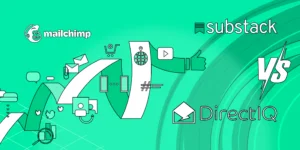
Substack Vs Mailchimp Vs DirectIQ (Which Is Best?)
When it comes to email marketing automation and contact list segmentation, DirectIQ is well-equipped to meet your needs. This all-encompassing platform comes with the necessary features to help you build scalable email marketing campaigns. Whether you are a small business owner or a CMO at a large enterprise, you can hit the ground running with DirectIQ.
Are you ready to get started? Sign up to DirectIQ for free today!
Want to check out more alternatives? Click here.







